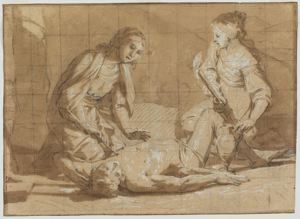St. Sebastian Nursed by Saint Irene and Attendant
Artist: Unknown Artist (Italian, 1600-1610-)
Medium: brush and brown wash over black chalk, squared in black, on brown paper
Dimensions: 10 1/8 in. x 14 in. (25.7 cm. x 35.56 cm.)
Credit Line: Bequest of the Honorable James Bowdoin III
Accession Number: 1811.96
- fleur-de-lis on three mounts within circle, M above (compare with that repr. in Fischer Pace 1979, p. 449, no. 18)
Type: watermark
Location:
Materials: - "No. 36"
Type: inscription
Location: verso of former mount (lost)
Materials: pen and ink
- James Bowdoin III( Collector, Boston) - 1811.
- Bowdoin College Museum of Art( Museum, Brunswick, Maine) 1811- . Bequest
- Old Master Drawings at Bowdoin College
- Bowdoin College Museum of Art. ( 5/17/1985 - 7/7/1985)
- Clark Art Institute. ( 9/14/1985 - 10/27/1985)
- University of Kansas. ( 1/19/1986 - 3/2/1986)
- Art Gallery of Ontario. ( 5/17/1986 - 6/29/1986)
- Drawing on Basics
- Bowdoin College Museum of Art. ( 10/14/1993 - 12/19/1993)
- Old Master Drawings from the Bowdoin College Museum of Art
- Timken Museum of Art. ( 5/13/2005 - 8/14/2005)
Type: catalogue Author: Henry Johnson Document Title: Catalogue of the Bowdoin College Art Collections Publ. Place: Brunswick, Maine Reference: no. 88 Remarks: (as Unknown) Section Title: Pt. I, The Bowdoin Drawings Date: 1885 Type: catalogue Author: Bowdoin College Museum of Art Document Title: Bowdoin Museum of Fine Arts, Walker Art Building Edition: 4th Publ. Place: Brunswick, Maine Reference: no. 88 Remarks: (as Unknown) Publisher: Bowdoin College Section Title: Descriptive Catalogue of the . . . Date: 1930 Type: exhibition catalogue Author: David P. Becker Document Title: Old Master Drawings at Bowdoin College Publ. Place: Brunswick, Maine Location: pp. 116-117 Reference: no. 53 (illus.) Publisher: Bowdoin College Date: 1985
Frits Lugt was the first to place this sheet as Italian, ca. 1630. In 1977 Konrad Oberhuber thought the drawling could be French, possibly near the style of Georges Lallemand (or Lallemant, ca. 1575/76–1636), a student of Jacques Bellange.1 Recently, however, Oberhuber has suggested that this drawing is indeed Italian, by a Veronese artist working in the style of Alessandro Turchi (ca. 1582–1650), if not actually by him.
Turchi studied with Felice Brusasorci, worked in Venice, and then settled in Rome by 1614, along with his Veronese compatriot Bassetti (BCMA 1930.184). He was influenced by the Venetian Carlo Saraceni and by the style of Caravaggio, who had died in 1610. Turchi became a member of the Accademia di San Luca in 1619 and participated in the decorations for the Sala Regia of the Palazzo Quirinale, among others.
The Bowdoin drawing resembles certain of Turchi's smaller paintings in its strong chiaroscuro, figural style, and nighttime motif,2 but comparisons with known Turchi drawings are less certain. Drawings in Munich and Stuttgart datable ca. 1620 and executed in similar technique of wash over black chalk offer the closest parallels,3 but the forms in the Bowdoin sheet do not seem to have quite the movement of those in Turchi's works.
1. A painting by Lallemand of this subject is repr. in Burlington Magazine, vol. 100, no. 660 (March 1958), p. 99, fig. 34 (as Vignon). It is attr. to Lallemand by Rosenberg, in International Exhibitions Foundation, French Master Drawings from the Rouen Museum (exh. cat.) (1981–1982), p. 49.
2. Cf. Verona 1974, cat. no. 91, repr. fig. 112, and E. Schleier, "Drawings by Alessandro Turchi," Master Drawings, vol. 9, no. 2 (1971), p. 147, fig. 2.
3. Cf Schleier, op. cit., pp. 147-48, respectively cat. nos. 2, 4, repr. pls. 18, 20.
Commentary credited to David P. Becker (or not otherwise captioned) appeared in his catalogue Old Master Drawings at Bowdoin College (Brunswick: Bowdoin College Museum of Art, 1985).


 Museum of Art
Museum of Art